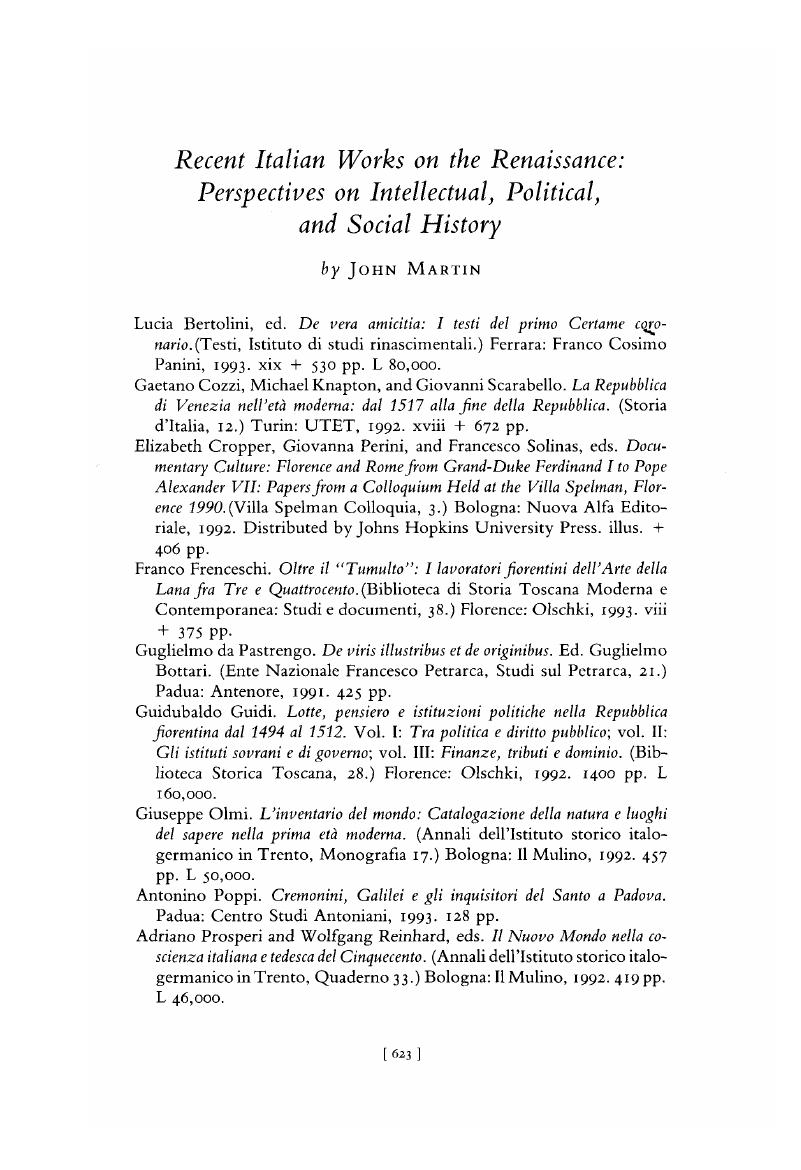No CrossRef data available.
Published online by Cambridge University Press: 20 November 2018

1 See, for example, J. H. Elliot's review of David Stannard's The American Holocaust in The New York Review of Books, 12 June 1993, 36-41, with a response by Stannard and Elliot's answer in the 21 October 1993 issue, 95-96. For an overview of much of the scholarship on Columbus and its relationship to the Quincentenary, see Simon Schama, “They all Laughed at Christopher Columbus,” The New Republic, 6 January 1992, 30-40.
2 On Dal Pozzo, see Francesco Solinas, Cassiano dal Pozzo: Atti del Seminario Internazionale di Studi (Rome: De Luca, 1989).
3 Compare Mario Biagioli, Galileo Courtier: The Practice of Science in the Culture of Absolutism (Chicago: University of Chicago Press, 1993).
4 See, for example, Guidubaldo Guidi, II governo della città-repubblica di Firenze del primo Quattrocento (Florence: Olschki, 1981), 3 vols.
5 Paul Grendler, Schooling in Renaissance Italy: Literacy and Learning, 1300-1600 (Baltimore and London: Johns Hopkins University Press, 1989).
6 Alfred Doren, Studien aus der Florentiner Wirtschaftsgeschichte, vol. I: Die Florentiner Wollentuchindustrie vom 14. bis zum 16Jahrhundert: Bin Beitrag zur Geschichte des modernen Kapitalismus (Stuttgart: Cotta, 1901).
7 Samuel Kline Cohn, Jr., The Laboring Classes in Renaissance Florence (New York: Academic Press, 1980).
8 This volume —which follows Michael Knapton and Gaetano Cozzi, La Repubblica di Venezia nell'età tnoderna: Dalla guerra di Chiogga al 1511 (Turin: UTET, 1986)—is made up of three significant essays —each of which could be a book by itself. I discuss only Cozzi's contributions here, but Michael Knapton's essay “Tra Dominante e Dominio (1517-1630)” is of great interest and offers an excellent synthesis of the social history of Venice and its relationship to its subject territories in the early modern period. Knapton's study, moreover, is more than a companion piece to Cozzi; it is clear that there is a growing consensus among political, social, and economic historians that the great cities of Italy cannot really be understood without careful attention to the territories they dominated. Finally, Giovanni Scarabella's “II Settecento” constitutes a much needed overview of the history of eighteenth-century Venice. The book treats themes far beyond the competence of this reviewer.
9 Cozzi's major works include i7 doge Niccolo Contarini: Ricerchc sul patriziato veneziano agli inizi del Seicento (Venice: Istituto per la collaborazione culturale, 1958); Paolo Sarpi tra Venezia e I'Europa (Turin: Einaudi, 1979); and Repubblica di Venezia estati italiani: politica e giustizia dal secolo XVI al secolo XVIII (Turin: Einaudi, 1982).
10 This is an expanded version of the author's Cremonini e Galilei inquisiti a Padova nel 1604: Nuovi document! d'archivio (Padua: Antenore, 1992).